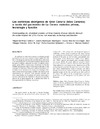Please use this identifier to cite or link to this item:
https://accedacris.ulpgc.es/jspui/handle/10553/20788
| Title: | Las cerámicas aborígenes de Gran Canaria (Islas Canarias) a través del yacimiento de La Cerera: materias primas, tecnología y función | Other Titles: | Understanding the aboriginal ceramics of Gran Canaria (Canary Islands) through the archaeological site of La Cerera: raw materials, technology and function | Authors: | del Pino Curbelo, Miguel Rodríguez Rodríguez, Amelia Buxeda Garrigós,Jaume Mangas, José Day, Peter M. González Quintero, Pedro Moreno Benítez, Marco |
UNESCO Clasification: | 550405 Prehistoria 550501 Arqueología 550502 Ciencia de la cerámica 510206 Habilidades artesanales |
Keywords: | Islas Canarias Gran Canaria producciones cerámicas prehispánicas X-ray fluorescence X-ray diffraction |
Issue Date: | 2016 | Journal: | Trabajos de Prehistoria | Abstract: | Se analizan los materiales cerámicos prehispánicos del yacimiento de La Cerera en Gran Canaria (siglos VII-XIII D.C.). Se integra la clasificación morfotécnica y funcional, y la caracterización instrumental mediante fluorescencia de rayos X (FRX), difracción de rayos X (DRX), petro- grafía óptica (PO) y microscopía electrónica de barrido (MEB) relacionando cada nivel de estudio aplicado. Como resultado se detectaron diferentes cadenas operativas, co- nectadas con la función de los vasos y su cronología. Ade- más se observaron importantes cambios diacrónicos en las características del material. Estos parecen coincidir con otros identificados en el registro del propio yacimiento y en otros sitios de la isla. También se discuten los posibles efectos de la intensificación de la producción sobre la homogeneidad de las fábricas cerámicas. This paper focuses on the study of the pre-Hispanic ceramics from the site of La Cerera (Gran Canaria) (7th century AD – 13th century AD). An integrated approach combining various levels of analysis has been carried out, employing morphological, technical and functional analysis of the pots, as well as their instrumental characterization: X-ray fluorescence (XRF), X-ray diffraction (XRD), optical petrography and scanning electron microscopy (SEM). As result, different operative chains have been detected, linked to function and chronology. Other differences with respect to the characteristics of the archaeological materials through time were also identified. Those transformations seem to coincide with others already observed for various elements of the aboriginal material culture at the site, as well as at other parts of the island. The effects of the intensification of pottery production on the homogeneity of the fabrics are also discussed. |
URI: | https://accedacris.ulpgc.es/handle/10553/20788 | ISSN: | 0082-5638 | DOI: | 10.3989/tp.2016.12165 | Source: | Trabajos de prehistoria [ISSN 0082-5638], v. 73 (1), p. 90-114 | Rights: | by-nc-nd | URL: | http://dialnet.unirioja.es/servlet/articulo?codigo=5764912 |
| Appears in Collections: | Artículos |
SCOPUSTM
Citations
12
checked on Jun 8, 2025
WEB OF SCIENCETM
Citations
10
checked on Jun 8, 2025
Page view(s)
216
checked on May 31, 2025
Download(s)
288
checked on May 31, 2025
Google ScholarTM
Check
Altmetric
Share
Export metadata
Items in accedaCRIS are protected by copyright, with all rights reserved, unless otherwise indicated.
